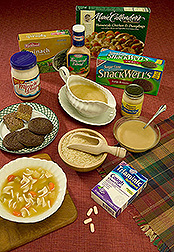This page has been archived and is being provided for reference purposes only. The page is no longer being updated, and therefore, links on the page may be invalid.
Read the magazine story to find out more. |
|
A New Way to Free up Rice's Valuable Starch and Protein
By Erin PeabodyJanuary 28, 2005
Rice starch is one of the food industry's best-kept secrets. It can replace fat or add a satiny finish to sauces and soups and is hypoallergenic enough to use in baby foods. But for decades, there's been no easy way to procure the finely-textured starch from milled rice grains--until now.
Agricultural Research Service food technologist Harmeet Guraya, at the agency's Southern Regional Research Center in New Orleans, La., has found a more efficient and environmentally-friendly way to separate a rice kernel's tightly-bound portions of starch and protein.
Rice starch is a soft, white powder consisting of tiny particles only a few microns in size. Because its particles are as small as fat globules, rice starch granules are the preferred starch for use in reduced-fat foods, like low-fat mayonnaise.
Rice protein, which is valued for its easy digestibility, can be found in infant foods and formula, as well as in special dietary goods designed for consumers with sensitivity to dairy products and other foods.
For 60 years, the only method to extract rice starch has relied on large quantities of sodium hydroxide. Clumps of rice protein and starch are steeped in an alkaline solution for several hours, which eventually frees up the starch molecules. But this process generates large amounts of salts and other potentially harmful waste products. Also, the rice protein that's produced is degraded by the corrosive action of the salts, making it unfit for human consumption.
Guraya has developed a method that instead relies on extremely high pressure to do the separating. He uses a special homogenizer that can physically split apart the starch-protein clumps by passing them through a tiny opening. Guraya's approach also yields a usable rice protein.
This discovery could help rebuild the rice starch and protein production industries in the United States, which now imports about $40 million worth of rice starch each year.
Read more about the rice-starch research in the February issue of Agricultural Research magazine.
ARS is the U.S. Department of Agriculture's chief scientific research agency.


